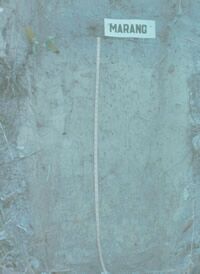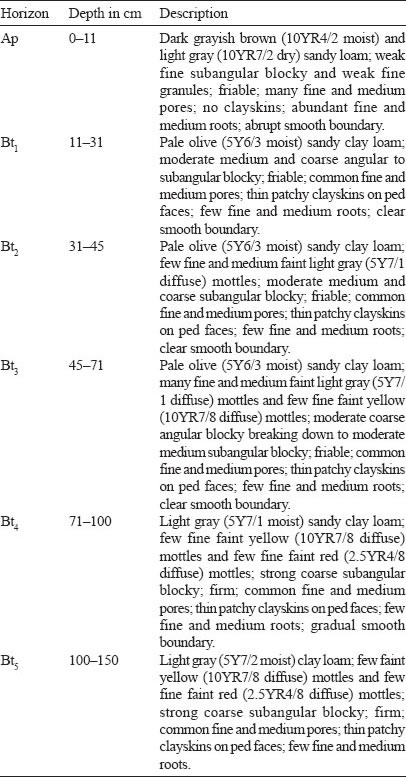Soil Profiles: Marang
Marang Series
The Marang Series is a member of the family of fine loamy, siliceous, isohyperthermic, yellow Allik Tualemkuts. These soils are developed over iron-poor sandy indurated shales. They are characterized by fine sandy clay loam subsoils with pale olive or pale yellow colours with weak to medium subangular blocky structures and friable to firm consistence. Patchy clayskins occur on ped faces. The soil colour changes to light gray below 50 cm depth where red mottles are also common. These pale coloured horizons show distinct mottling. Sometimes a thin band of vein quartz fragments occurs between the upper and lower parts of the profile. Most of these soils are deep although some moderately deep soils have also been encountered. These soils commonly occur on rolling to hilly terrain. Chemically these soils have a CECclay of more than 24 cmol in some subhorizon between 25 to 100 cm of the soil surface.
Type Location
The Marang Series was first established by Panton (1958) during the Reconnaissance Soil Survey of Terengganu near Marang town. The above pedon was described by K.F. Loh and Paramananthan and studied in detail by Loh (1981) at the Bukit Goh Oil Palm Scheme near Kuantan on the midslope of low undulating to rolling hills. Location: Topographic Sheet 4360, 3°55′ N, 103°15’15” E (Grid Reference 4360 – 850330 m).
Range in Characteristics
Very little is known about the range in characteristics of the Marang Series. The textures in the subsoil are uniformly fine sandy clay loam with clay contents gradually increasing with depth to over 100 cm. The colours in the upper part of the B to just below 50 cm has hues of 10YR, 2.5Y or 5Y but often have chromas of three or four. The values are often moderate to high (> 5) resulting in colours ranging from very pale brown, pale brown, light yellowish brown; pale yellow and pale olive (10YR6/3, 6/4, 7/3, 7/4, 8/3, 8/4; 2.5Y6/4, 7/4, 8/4; 5Y6/3, 6/4, 7/3, 7/4, 8/3, 8/4). At depths below 50 cm and below the vein quartz stoneline the colour becomes paler – light gray to white. Often a layer of vein quartz occurs between these two layers. Few red mottles occur in these lower horizons. Structures are weak to moderate medium and fine subangular blocky and consistence friable to firm. Patchy clayskins are common on ped faces. Drainage in these soils is moderately well to somewhat imperfect. After rain, water may stand on the surface. The depth at which the weathered shale saprolite occurs varies from around 60 cm to just over one metre. Soils of the Marang Series occur over a wide range on terrain classes ranging from undulating, rolling to hilly.
Competing Soils and Their Differences
Soils of the Marang Series may be mistaken for other soils which have similar pale colours such as the Batu Anam Series, Apek Series, Chenian Series and Pohoi Series. The Pohoi Series, Chenian Series and Durian Series are all heavier textured and stronger coloured. The Batu Anam Series is paler coloured and also heavier textured. The Apek Series which often occurs together with the Marang Series has similar fine sandy clay loam textures but the colours of the Apek Series are paler with chromas of 2 or less while the Marang Series has chromas of 3 and 4. No soils in Sabah with a deep argillic horizon with pale yellow colours and fine sandy loam textures have been identified to-date. In Sarawak, some soils mapped as the Durin Series (Grey-White Podzolics) could possibly be correlated with soils of the Marang Series. More data is required before this can be done.
Setting
Soils of the Marang Series have been mapped mainly over undulating to rolling terrain. Occasionally they have also been mapped on hilly to steep terrain.
Principal Associated Soils
The Marang Series has to-date been mapped in association with the Apek and Kuala Brang Series. The Apek Series has pale colours with chromas of 2 or less while the Kuala Brang has chromas of 6 or 8. The Kuala Brang Series is also heavier textured.
Drainage and Permeability
Soils of the Marang Series are moderately well to imperfectly drained. The permeability in the upper 50 cm is moderate to high but this becomes slow to moderate at depth.
Use and Vegetation
Rubber is by far the commonest crop grown on this soil to-date although oil palm has also recently been planted. Some of the areas with this soil are still under forest while others are under fruit trees or secondary forest.
Distribution and Extent
The main extent of the Marang Series is on the East Coast. These soils are extensive in Terengganu around the town of Marang and Kampong Buloh. They have also been mapped in the Bukit Goh and Rompin Plateau areas of Pahang and in eastern part of Negeri Sembilan and Johor.
Series Established
This soil was established near the town of Marang, Terengganu. The source of name is the town of Marang, Terengganu, Peninsular Malaysia.
Remarks on Classification
The Marang Series is classified here according to the Malaysian Soil Taxonomy – Second Approximation (Paramananthan 1998) as a member of the fine loamy, siliceous, isohyperthermic, yellow family of the Allik Tualemkuts. They are classified as soils having an argillic horizon with low base saturation and a clay distribution that does not decrease significantly with depth. These soils have a fine sandy loam colour with light gray colours. The CECclay is more than 24 cmol in some sub-horizon between 25 to 100 cm depth. In the Keys to Soil Taxonomy – Eighth Edition (Soil Survey Staff 1998) the Marang Series would probably be Typic Paleudults. In the FAO/UNESCO Soil Map of the World – Revised Legend (FAO 1990) the Marang Series would probably be Haplic Alisols.
Suitability for Agriculture
Little is known of the suitability of the Marang Series for agriculture. It is marginally suitable for rubber due to its poor infiltration rate but oil palm would probably perform better on the soil provided the terrain was suitable.



